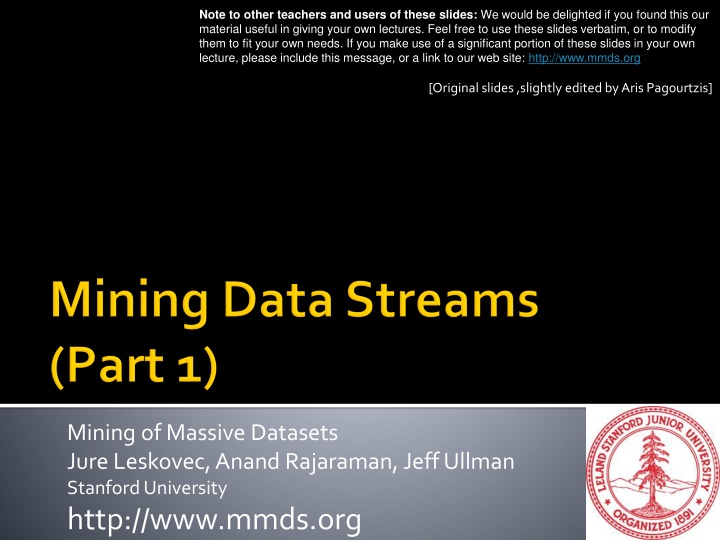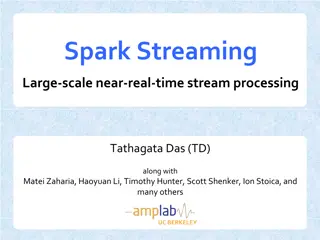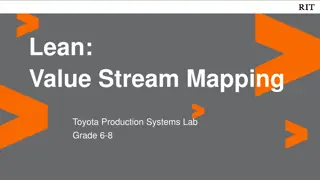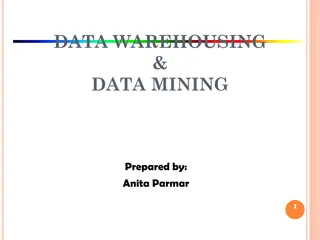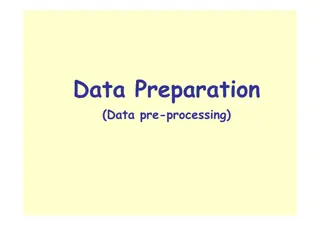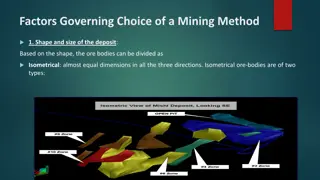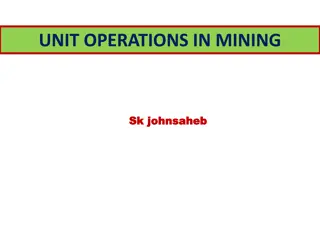Stream Management and Online Learning in Data Mining
Stream management is crucial in scenarios where data is infinite and non-stationary, requiring algorithms like Stochastic Gradient Descent for online learning. Techniques like Locality Sensitive Hashing, PageRank, and SVM are used for critical calculations on streaming data in fields such as machine learning and community detection.
Download Presentation

Please find below an Image/Link to download the presentation.
The content on the website is provided AS IS for your information and personal use only. It may not be sold, licensed, or shared on other websites without obtaining consent from the author.If you encounter any issues during the download, it is possible that the publisher has removed the file from their server.
You are allowed to download the files provided on this website for personal or commercial use, subject to the condition that they are used lawfully. All files are the property of their respective owners.
The content on the website is provided AS IS for your information and personal use only. It may not be sold, licensed, or shared on other websites without obtaining consent from the author.
E N D
Presentation Transcript
Note to other teachers and users of these slides: We would be delighted if you found this our material useful in giving your own lectures. Feel free to use these slides verbatim, or to modify them to fit your own needs. If you make use of a significant portion of these slides in your own lecture, please include this message, or a link to our web site: http://www.mmds.org [Original slides ,slightly edited by Aris Pagourtzis] Mining of Massive Datasets Jure Leskovec, Anand Rajaraman, Jeff Ullman Stanford University http://www.mmds.org
Infinite data High dim. data Graph data Machine learning Apps Locality sensitive hashing Filtering data streams PageRank, SimRank Recommen der systems SVM Community Detection Queries on streams Decision Trees Association Rules Clustering Dimensional ity reduction Duplicate document detection Spam Detection Web Perceptron, kNN advertising J. Leskovec, A. Rajaraman, J. Ullman: Mining of Massive Datasets, http://www.mmds.org 2
In many data mining situations, we do not know the entire data set in advance Stream Management is important when the input rate is controlled externally: Google queries Twitter or Facebook status updates We can think of the data as infinite and non-stationary (the distribution changes over time) J. Leskovec, A. Rajaraman, J. Ullman: Mining of Massive Datasets, http://www.mmds.org 3
Input elements enter at a rapid rate, at one or more input ports (i.e., streams) We call elements of the stream tuples The system cannot store the entire stream accessibly Q: How do you make critical calculations about the stream using a limited amount of (secondary) memory? J. Leskovec, A. Rajaraman, J. Ullman: Mining of Massive Datasets, http://www.mmds.org 4
Stochastic Gradient Descent (SGD) is an example of a stream algorithm In Machine Learning we call this: Online Learning Allows for modeling problems where we have a continuous stream of data We want an algorithm to learn from it and slowly adapt to the changes in data Idea: Do slow updates to the model SGD (SVM, Perceptron) makes small updates So: First train the classifier on training data. Then: For every example from the stream, we slightly update the model (using small learning rate) J. Leskovec, A. Rajaraman, J. Ullman: Mining of Massive Datasets, http://www.mmds.org 5
Ad-Hoc Queries Standing Queries . . . 1, 5, 2, 7, 0, 9, 3 Output . . . a, r, v, t, y, h, b Processor . . . 0, 0, 1, 0, 1, 1, 0 time Streams Entering. Each is stream is composed of elements/tuples Limited Working Storage Archival Storage J. Leskovec, A. Rajaraman, J. Ullman: Mining of Massive Datasets, http://www.mmds.org 6
Types of queries one wants on answer on a data stream: (we ll do these today) Sampling data from a stream Construct a random sample Queries over sliding windows Number of items of type x in the last k elements of the stream J. Leskovec, A. Rajaraman, J. Ullman: Mining of Massive Datasets, http://www.mmds.org 7
Types of queries one wants on answer on a data stream: (we ll do these next time) Filtering a data stream Select elements with property x from the stream Counting distinct elements Number of distinct elements in the last k elements of the stream Estimating moments Estimate avg./std. dev. of last kelements Finding frequent elements J. Leskovec, A. Rajaraman, J. Ullman: Mining of Massive Datasets, http://www.mmds.org 8
Mining query streams Google wants to know what queries are more frequent today than yesterday Mining click streams Yahoo wants to know which of its pages are getting an unusual number of hits in the past hour Mining social network news feeds E.g., look for trending topics on Twitter, Facebook J. Leskovec, A. Rajaraman, J. Ullman: Mining of Massive Datasets, http://www.mmds.org 9
Sensor Networks Many sensors feeding into a central controller Telephone call records Data feeds into customer bills as well as settlements between telephone companies IP packets monitored at a switch Gather information for optimal routing Detect denial-of-service attacks J. Leskovec, A. Rajaraman, J. Ullman: Mining of Massive Datasets, http://www.mmds.org 10
As the stream grows the sample also gets bigger
Since we can not store the entire stream, one obvious approach is to store a sample Two different problems: (1) Sample a fixed proportion of elements in the stream (say 1 in 10) (2) Maintain a random sample of fixed size over a potentially infinite stream At any time k we would like a random sample of s elements What is the property of the sample we want to maintain? For all time steps k, each of k elements seen so far has equal prob. of being sampled J. Leskovec, A. Rajaraman, J. Ullman: Mining of Massive Datasets, http://www.mmds.org 12
Problem 1: Sampling fixed proportion Scenario: Search engine query stream Stream of tuples: (user, query, time) Answer questions such as:How often did a user run the same query in a single days Have space to store 1/10th of query stream Na ve solution: Generate a random integer in [0..9] for each query Store the query if the integer is 0, otherwise discard J. Leskovec, A. Rajaraman, J. Ullman: Mining of Massive Datasets, http://www.mmds.org 13
Simple question: What fraction of queries by an average search engine user are duplicates? Suppose each user issues x queries once and d queries twice (total of x+2d queries) Correct answer:d/(x+d) Proposed solution: We keep 10% of the queries Sample will contain x/10 of the singleton queries and 2d/10 of the duplicate queries at least once But only d/100 pairs of duplicates d/100 = 1/10 1/10 d Of d duplicates 18d/100 appear exactly once 18d/100 = ((1/10 9/10)+(9/10 1/10)) d ? ? So the sample-based answer is 100 ? 100+18? = ? 10+ ???+??? 100 J. Leskovec, A. Rajaraman, J. Ullman: Mining of Massive Datasets, http://www.mmds.org 14
Solution: Pick 1/10th of users and take all their searches in the sample Use a hash function that hashes the user name or user id uniformly into 10 buckets J. Leskovec, A. Rajaraman, J. Ullman: Mining of Massive Datasets, http://www.mmds.org 15
Stream of tuples with keys: Key is some subset of each tuple s components e.g., tuple is (user, search, time); key is user Choice of key depends on application To get a sample of a/b fraction of the stream: Hash each tuple s key uniformly into b buckets Pick the tuple if its hash value is at most a Hash table with b buckets, pick the tuple if its hash value is at most a. How to generate a 30% sample? Hash into b=10 buckets, take the tuple if it hashes to one of the first 3 buckets J. Leskovec, A. Rajaraman, J. Ullman: Mining of Massive Datasets, http://www.mmds.org 16
As the stream grows, the sample is of fixed size
Problem 2: Fixed-size sample Suppose we need to maintain a random sample S of size exactly s tuples E.g., main memory size constraint Why?Don t know length of stream in advance Suppose at time n we have seen n items Each item is in the sample S with equal prob. s/n How to think about the problem: say s = 2 Stream:a x c y z k c d e g At n= 5, each of the first 5 tuples is included in the sample S with equal prob. At n= 7, each of the first 7 tuples is included in the sample S with equal prob. Impractical solution would be to store all the n tuples seen so far and out of them pick s at random J. Leskovec, A. Rajaraman, J. Ullman: Mining of Massive Datasets, http://www.mmds.org 18
Algorithm (a.k.a. Reservoir Sampling) Store all the first s elements of the stream to S Suppose we have seen n-1 elements, and now the nth element arrives (n > s) With probability s/n, keep the nth element, else discard it If we picked the nth element, then it replaces one of the s elements in the sample S, picked uniformly at random Claim: This algorithm maintains a sample S with the desired property: After n elements, the sample contains each element seen so far with probability s/n J. Leskovec, A. Rajaraman, J. Ullman: Mining of Massive Datasets, http://www.mmds.org 19
We prove this by induction: Assume that after n elements, the sample contains each element seen so far with probability s/n We need to show that after seeing element n+1 the sample maintains the property Sample contains each element seen so far with probability s/(n+1) Base case: After we see n=s elements the sample S has the desired property Each out of n=s elements is in the sample with probability s/s = 1 J. Leskovec, A. Rajaraman, J. Ullman: Mining of Massive Datasets, http://www.mmds.org 20
Inductive hypothesis: After n elements, the sample S contains each element seen so far with prob. s/n Now element n+1 arrives Inductive step: For elements already in S, probability that the algorithm keeps it in S is: 1 + + n n Element n+1 discarded not discarded sample not picked 1 s s s n + = + 1 1 1 s n Element in the Element n+1 So, at time n, tuples in S were there with prob. s/n Time n n+1, tuple stayed in S with prob. n/(n+1) So prob. tuple is in S at time n+1= ? ? ? ? ?+?= ?+? J. Leskovec, A. Rajaraman, J. Ullman: Mining of Massive Datasets, http://www.mmds.org 21
A useful model of stream processing is that queries are about a window of length N the N most recent elements received Interesting case: N is so large that the data cannot be stored in memory, or even on disk Or, there are so many streams that windows for all cannot be stored Amazon example: For every product X we keep 0/1 stream of whether that product was sold in the n-th transaction We want answer queries, how many times have we sold X in the last k sales J. Leskovec, A. Rajaraman, J. Ullman: Mining of Massive Datasets, http://www.mmds.org 23
Sliding window on a single stream: N = 6 q w e r t y u i o p a s d f g h j k l z x c v b n m q w e r t y u i o p a s d f g h j k l z x c v b n m q w e r t y u i o p a s d f g h j k l z x c v b n m q w e r t y u i o p a s d f g h j k l z x c v b n m Past Future J. Leskovec, A. Rajaraman, J. Ullman: Mining of Massive Datasets, http://www.mmds.org 24
Problem: Given a stream of 0s and 1s Be prepared to answer queries of the form How many 1s are in the last k bits? where k N Obvious solution: Store the most recent N bits When new bit comes in, discard the N+1st bit 0 1 0 0 1 1 0 1 1 1 0 1 0 1 0 1 1 0 1 1 0 1 1 0 Suppose N=6 Past Future J. Leskovec, A. Rajaraman, J. Ullman: Mining of Massive Datasets, http://www.mmds.org 25
You can not get an exact answer without storing the entire window Real Problem: What if we cannot afford to store N bits? E.g., we re processing 1 billion streams and N = 1 billion 0 1 0 0 1 1 0 1 1 1 0 1 0 1 0 1 1 0 1 1 0 1 1 0 Past Future But we are happy with an approximate answer J. Leskovec, A. Rajaraman, J. Ullman: Mining of Massive Datasets, http://www.mmds.org 26
Q: How many 1s are in the last N bits? A simple solution that does not really solve our problem: Uniformity assumption N 0 1 0 0 1 1 1 0 0 0 1 0 1 0 0 1 0 0 0 1 0 1 1 0 1 1 0 1 1 1 0 0 1 0 1 0 1 1 0 0 1 1 0 1 0 Past Future Maintain 2 counters: S: number of 1s from the beginning of the stream Z: number of 0s from the beginning of the stream How many 1s are in the last N bits? ? But, what if stream is non-uniform? What if distribution changes over time? ? ?+? J. Leskovec, A. Rajaraman, J. Ullman: Mining of Massive Datasets, http://www.mmds.org 27
[Datar, Gionis, Indyk, Motwani] DGIM solution that does not assume uniformity We store ?(log??) bits per stream Solution gives approximate answer, never off by more than 50% Error factor can be reduced to any fraction > 0, with more complicated algorithm and proportionally more stored bits J. Leskovec, A. Rajaraman, J. Ullman: Mining of Massive Datasets, http://www.mmds.org 28
Solution that doesnt (quite) work: Summarize exponentially increasing regions of the stream, looking backward Keep 1 or 2 buckets of each size has 7 1s Window of width 16 7 4 5 ? 2 2 1 1 1 0 0 1 0 0 1 1 1 0 0 1 1 0 1 0 0 1 0 0 0 1 0 1 1 0 1 1 0 1 1 1 0 0 1 0 1 0 1 1 0 0 1 1 0 1 0 N We can reconstruct the count of the last N bits, except we are not sure how many of the last 71s are included in the N J. Leskovec, A. Rajaraman, J. Ullman: Mining of Massive Datasets, http://www.mmds.org 29
Stores only O(log2N ) bits ?(log?)counts of log?? bits each Easy update as more bits enter Error in count no greater than the number of 1sin the unknown area J. Leskovec, A. Rajaraman, J. Ullman: Mining of Massive Datasets, http://www.mmds.org 30
As long as the 1s are fairly evenly distributed, the error due to the unknown region is small no more than 50% But it could be that (almost) all the 1s are in the unknown area at the end In that case, the error is unbounded! 10 0 2 ? 1 0 0 0 0 0 0 1 1 1 1 1 1 0 0 1 1 0 1 0 0 1 0 0 0 0 0 0 0 0 1 0 0 1 0 0 0 0 0 0 1 0 0 0 0 0 0 0 0 0 0 N J. Leskovec, A. Rajaraman, J. Ullman: Mining of Massive Datasets, http://www.mmds.org 31
[Datar, Gionis, Indyk, Motwani] Idea: Instead of summarizing fixed-length blocks, summarize blocks with specific number of 1s: Let the block sizes (number of 1s) increase exponentially When there are few 1s in the window, block sizes stay small, so errors are small 1001010110001011010101010101011010101010101110101010111010100010110010 N J. Leskovec, A. Rajaraman, J. Ullman: Mining of Massive Datasets, http://www.mmds.org 32
Each bit in the stream has a timestamp, starting 1, 2, Record timestamps modulo N (the window size), so we can represent any relevanttimestamp in ?(?????) bits J. Leskovec, A. Rajaraman, J. Ullman: Mining of Massive Datasets, http://www.mmds.org 33
A bucket in the DGIM method is a record consisting of: (A) The timestamp of its end [O(log N) bits] (B) The number of 1s between its beginning and end [O(log log N) bits] Constraint on buckets: Number of 1s must be a power of 2 That explains the O(log log N)in (B) above 1001010110001011010101010101011010101010101110101010111010100010110010 N J. Leskovec, A. Rajaraman, J. Ullman: Mining of Massive Datasets, http://www.mmds.org 34
Either one or two buckets with the same power-of-2 number of 1s Buckets do not overlap in timestamps Buckets are sorted by size Earlier buckets are not smaller than later buckets Buckets disappear when their end-time is > N time units in the past J. Leskovec, A. Rajaraman, J. Ullman: Mining of Massive Datasets, http://www.mmds.org 35
At least 1 of size 16. Partially beyond window. 2 of size 8 2 of size 4 1 of size 2 2 of size 1 1001010110001011010101010101011010101010101110101010111010100010110010 N Three properties of buckets that are maintained: - Either one or two buckets with the same power-of-2 number of 1s - Buckets do not overlap in timestamps - Buckets are sorted by size J. Leskovec, A. Rajaraman, J. Ullman: Mining of Massive Datasets, http://www.mmds.org 36
When a new bit comes in, drop the last (oldest) bucket if its end-time is prior to N time units before the current time 2 cases: Current bit is 0 or 1 If the current bit is 0: no other changes are needed J. Leskovec, A. Rajaraman, J. Ullman: Mining of Massive Datasets, http://www.mmds.org 37
If the current bit is 1: (1) Create a new bucket of size 1, for just this bit End timestamp = current time (2) If there are now three buckets of size 1, combine the oldest two into a bucket of size 2 (3) If there are now three buckets of size 2, combine the oldest two into a bucket of size 4 (4) And so on J. Leskovec, A. Rajaraman, J. Ullman: Mining of Massive Datasets, http://www.mmds.org 38
Current state of the stream: 1001010110001011010101010101011010101010101110101010111010100010110010 Bit of value 1 arrives 0010101100010110101010101010110101010101011101010101110101000101100101 Two orange buckets get merged into a yellow bucket 0010101100010110101010101010110101010101011101010101110101000101100101 Next bit 1 arrives, new orange bucket is created, then 0 comes, then 1: 0101100010110101010101010110101010101011101010101110101000101100101101 Buckets get merged 0101100010110101010101010110101010101011101010101110101000101100101101 State of the buckets after merging 0101100010110101010101010110101010101011101010101110101000101100101101 J. Leskovec, A. Rajaraman, J. Ullman: Mining of Massive Datasets, http://www.mmds.org 39
To estimate the number of 1s in the most recent N bits: 1. Sum the sizes of all buckets but the last (note size means the number of 1s in the bucket) 2. Add half the size of the last bucket Remember: We do not know how many 1s of the last bucket are still within the wanted window J. Leskovec, A. Rajaraman, J. Ullman: Mining of Massive Datasets, http://www.mmds.org 40
At least 1 of size 16. Partially beyond window. 2 of size 8 2 of size 4 1 of size 2 2 of size 1 1001010110001011010101010101011010101010101110101010111010100010110010 N J. Leskovec, A. Rajaraman, J. Ullman: Mining of Massive Datasets, http://www.mmds.org 41
Why is error 50%? Lets prove it! Suppose the last bucket has size 2r Then by assuming 2r-1(i.e., half) of its 1s are still within the window, we make an error of at most 2r-1 Since there is at least one bucket of each of the sizes less than 2r, the true sum is at least 1 + 2 + 4 + .. + 2r-1 = 2r -1 Thus, error at most 50% At least 16 1s 111111110000000011101010101011010101010101110101010111010100010110010 N J. Leskovec, A. Rajaraman, J. Ullman: Mining of Massive Datasets, http://www.mmds.org 42
Instead of maintaining 1 or 2 of each size bucket, we allow either r-1 or r buckets (r > 2) Except for the largest size buckets; we can have any number between 1 and r of those Error is at most O(1/r) By picking r appropriately, we can tradeoff between number of bits we store and the error J. Leskovec, A. Rajaraman, J. Ullman: Mining of Massive Datasets, http://www.mmds.org 43
Can we use the same trick to answer queries How many 1 s in the last k? where k < N? A: Find earliest bucket B that at overlaps with k. Number of 1s is the sum of sizes of more recent buckets + size of B 1001010110001011010101010101011010101010101110101010111010100010110010 k Can we handle the case where the stream is not bits, but integers, and we want the sum of the last k elements? J. Leskovec, A. Rajaraman, J. Ullman: Mining of Massive Datasets, http://www.mmds.org 44
Stream of positive integers We want the sum of the last kelements Amazon: Avg. price of last k sales Solution: (1) If you know all have at most m bits Treat m bits of each integer as a separate stream Use DGIM to count 1s in each integer The sum is = ?=0 (2) Use buckets to keep partial sums Sum of elements in size b bucket is at most 2b ci estimated count for i-th bit ? 1??2? Idea: Sum in each bucket is at most 2b (unless bucket has only 1 integer) Bucket sizes: 8 16 2 5 7 1 3 8 4 6 7 9 1 3 7 6 5 3 5 7 1 3 3 1 2 2 6 2 5 7 1 3 8 4 6 7 9 1 3 7 6 5 3 5 7 1 3 3 1 2 2 6 3 2 5 7 1 3 8 4 6 7 9 1 3 7 6 5 3 5 7 1 3 3 1 2 2 6 3 2 2 5 7 1 3 8 4 6 7 9 1 3 7 6 5 3 5 7 1 3 3 1 2 2 6 3 2 5 4 2 1 J. Leskovec, A. Rajaraman, J. Ullman: Mining of Massive Datasets, http://www.mmds.org 45
Sampling a fixed proportion of a stream Sample size grows as the stream grows Sampling a fixed-size sample Reservoir sampling Counting the number of 1s in the last N elements Exponentially increasing windows Extensions: Number of 1s in any last k (k < N) elements Sums of integers in the last N elements J. Leskovec, A. Rajaraman, J. Ullman: Mining of Massive Datasets, http://www.mmds.org 46
